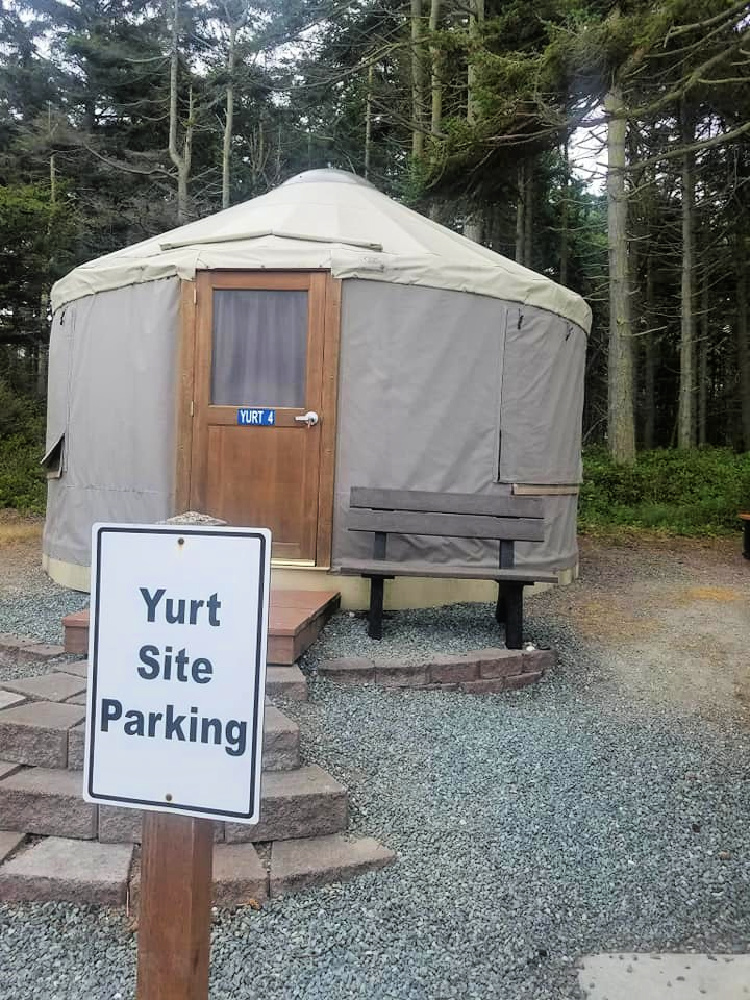Yurt camping is camping in a yurt, a circular, tent-like structure. It offers a more comfortable and often more luxurious camping experience compared to traditional tent camping. This article will explore everything you need to know about yurt camping, including its definition, benefits, costs, locations, necessary equipment, and a comparison to tent camping.

Image Source: thetravelinghikingmom.com
Deciphering the Yurt Camping Definition
A yurt camping definition describes an outdoor accommodation experience that blends the ruggedness of camping with the comfort and amenities of a cabin. Yurts are portable, circular dwellings traditionally used by nomadic groups in Central Asia. Modern yurts used for camping are typically made with a wooden or metal frame covered with durable canvas or other weather-resistant materials. Renting a yurt for camping offers a unique way to connect with nature without sacrificing comfort.
Origins of the Yurt
Yurts have a rich history, originating in Central Asia with nomadic cultures like the Mongols and Turks. These structures were designed to be easily portable and provide shelter in harsh climates. Modern yurts have evolved, incorporating modern materials and construction techniques while retaining the traditional circular design.
Exploring Yurt Camping Benefits
There are many yurt camping benefits that make it an appealing option for outdoor enthusiasts.
- Comfort and Space: Yurts offer significantly more space than traditional tents, allowing you to stand up and move around comfortably.
- Weather Protection: Yurts are designed to withstand various weather conditions, providing better protection from wind, rain, and snow than tents.
- Amenities: Many yurts come equipped with amenities like beds, furniture, and even heating or air conditioning, offering a glamping in yurts experience.
- Unique Experience: Staying in a yurt provides a unique and memorable camping experience that differs from traditional tent camping.
- Reduced Setup Time: Setting up a yurt is typically easier and faster than setting up a large tent, allowing you more time to relax and enjoy your surroundings.
Evaluating Yurt Camping Cost
The yurt camping cost can vary widely depending on several factors. Understanding these factors can help you budget appropriately for your trip.
Factors Affecting Cost
- Location: Yurts located in popular tourist destinations or near national parks may be more expensive.
- Amenities: Yurts with more amenities, such as private bathrooms, kitchens, or hot tubs, will generally cost more.
- Season: Prices may be higher during peak seasons, such as summer and holidays.
- Size: Larger yurts that can accommodate more people typically have a higher price tag.
- Rental Company: Different rental companies may have varying pricing structures.
Estimating Yurt Camping Costs
Here’s a general estimate of what you might expect to pay for yurt camping:
| Type of Yurt | Average Cost per Night |
|---|---|
| Basic Yurt | \$75 – \$150 |
| Mid-Range Yurt | \$150 – \$300 |
| Luxury Yurt | \$300+ |
Discovering Yurt Camping Locations
Yurt camping locations can be found across the United States and around the world. Here are some popular areas where you can find yurt rentals:
- National Parks: Many national parks, such as Yosemite, Yellowstone, and Olympic National Park, offer yurt camping options.
- State Parks: State parks are another great resource for finding yurt camping sites.
- Private Campgrounds: Private campgrounds often offer yurts as an alternative to traditional tent camping.
- Glamping Resorts: Glamping resorts specialize in luxury camping experiences and may offer yurts with high-end amenities.
Finding the Right Location
When choosing a yurt camping location, consider the following factors:
- Accessibility: How easy is it to get to the yurt site? Do you need a four-wheel-drive vehicle?
- Activities: What activities are available in the area, such as hiking, fishing, or kayaking?
- Amenities: What amenities are available at the yurt site, such as restrooms, showers, and cooking facilities?
- Scenery: Do you prefer a location with mountain views, forest surroundings, or a lakeside setting?
Gathering Yurt Camping Equipment
While many yurts come equipped with basic amenities, there are some yurt camping equipment items you should bring to ensure a comfortable and enjoyable experience.
Essential Gear
- Sleeping Bags and Pillows: While some yurts provide beds, you’ll still need to bring your own bedding for warmth and comfort.
- Cooking Supplies: If the yurt doesn’t have a kitchen, bring a portable stove, cookware, and utensils for preparing meals.
- Food and Water: Pack enough food and water for the duration of your trip.
- Lighting: Bring a flashlight, headlamp, or lantern for navigating around the yurt at night.
- Clothing: Dress in layers to accommodate changing weather conditions.
- First-Aid Kit: Be prepared for minor injuries with a well-stocked first-aid kit.
- Insect Repellent: Protect yourself from mosquitoes and other insects.
- Camp Chairs: Bring chairs for relaxing outside the yurt.
Optional Gear
- Portable Toilet: If the yurt doesn’t have a bathroom, a portable toilet can be a convenient option.
- Camp Shower: For longer stays, a camp shower can provide a refreshing way to clean up.
- Entertainment: Bring books, games, or other forms of entertainment for downtime.
- Binoculars: Enhance your wildlife viewing experience with a pair of binoculars.
Yurt Camping vs Tent Camping
Yurt camping vs tent camping offers distinct experiences with different advantages and disadvantages.
Comfort and Space
Yurts provide significantly more comfort and space than tents. You can stand up, move around freely, and enjoy amenities like beds and furniture. Tents, on the other hand, are more compact and lightweight, making them ideal for backpacking and remote camping.
Weather Protection
Yurts offer superior weather protection compared to tents. Their sturdy construction and insulation provide better protection from wind, rain, and snow. Tents can be vulnerable to strong winds and heavy rain, potentially leading to discomfort and even damage.
Cost
Tent camping is generally more affordable than yurt camping. Tents are less expensive to purchase, and tent campsites typically cost less than yurt rentals.
Portability
Tents are much more portable than yurts. They are lightweight and easy to pack, making them suitable for backpacking and other activities where portability is essential. Yurts are semi-permanent structures that are not designed to be moved frequently.
Setup
Setting up a tent is typically faster and easier than setting up a yurt. However, modern yurts are designed for relatively easy assembly compared to traditional yurts.
| Feature | Yurt Camping | Tent Camping |
|---|---|---|
| Comfort | Higher, more space, amenities | Lower, less space, basic |
| Weather Protection | Superior, sturdy construction | Limited, vulnerable to elements |
| Cost | Higher, rental fees | Lower, equipment purchase |
| Portability | Lower, semi-permanent | Higher, lightweight and portable |
| Setup | More involved | Simpler and quicker |
Fathoming the Yurt Camping Experience
The yurt camping experience is unique and memorable, offering a blend of comfort and nature.
A Typical Day Yurt Camping
- Morning: Wake up to the sounds of nature and enjoy a leisurely breakfast inside your cozy yurt.
- Daytime: Explore the surrounding area with activities like hiking, fishing, or kayaking.
- Evening: Relax by a campfire, stargaze, and enjoy the peace and quiet of the outdoors.
- Night: Retreat to your comfortable yurt for a good night’s sleep, sheltered from the elements.
Connecting with Nature
Yurt camping provides a unique opportunity to connect with nature without sacrificing comfort. You can enjoy the beauty of the outdoors while having a comfortable and secure place to retreat to.
Yurt Camping Pros and Cons
Examining yurt camping pros and cons can help you determine if it’s the right choice for your next outdoor adventure.
Pros
- Comfort: Yurts offer a comfortable and spacious camping experience with amenities like beds and furniture.
- Weather Protection: Yurts provide excellent protection from wind, rain, and snow.
- Unique Experience: Staying in a yurt is a unique and memorable way to connect with nature.
- Reduced Setup Time: Setting up a yurt is typically easier than setting up a large tent.
Cons
- Cost: Yurt camping can be more expensive than traditional tent camping.
- Portability: Yurts are not as portable as tents, making them unsuitable for backpacking.
- Availability: Yurt camping locations may be limited, especially in popular areas.
- Maintenance: Yurts require regular maintenance to keep them in good condition.
Glamping in Yurts
Glamping in yurts takes the comfort and luxury of yurt camping to the next level. Glamping yurts often include amenities like private bathrooms, fully equipped kitchens, comfortable furniture, and even hot tubs.
Features of Glamping Yurts
- Private Bathrooms: Glamping yurts often have private bathrooms with hot showers and flushing toilets.
- Fully Equipped Kitchens: Some glamping yurts have fully equipped kitchens with stoves, refrigerators, and all the necessary cookware.
- Comfortable Furniture: Glamping yurts feature comfortable furniture, such as plush beds, sofas, and chairs.
- Heating and Air Conditioning: Many glamping yurts have heating and air conditioning to ensure a comfortable temperature year-round.
- Outdoor Amenities: Glamping yurts may also include outdoor amenities like decks, fire pits, and hot tubs.
Renting a Yurt for Camping
Renting a yurt for camping is a straightforward process. Follow these steps to find and book the perfect yurt for your next adventure:
Steps to Rent a Yurt
- Research Locations: Start by researching yurt camping locations in your desired area.
- Check Availability: Check the availability of yurts at your chosen locations.
- Compare Amenities and Prices: Compare the amenities and prices of different yurts to find the best option for your needs and budget.
- Book Your Yurt: Once you’ve found the perfect yurt, book it online or by contacting the rental company directly.
- Confirm Your Reservation: Confirm your reservation and make sure you understand the rental agreement and cancellation policy.
Popular Rental Platforms
- Airbnb: Airbnb offers a wide variety of yurt rentals in different locations.
- Hipcamp: Hipcamp specializes in unique camping experiences, including yurt camping.
- VRBO: VRBO offers vacation rentals, including yurts, in various destinations.
Frequently Asked Questions (FAQ)
-
Are yurts safe in all weather conditions?
Yes, yurts are designed to withstand various weather conditions, including strong winds, heavy rain, and snow. However, it’s always a good idea to check the forecast and be prepared for potential weather changes.
* Can I bring my pet yurt camping?Some yurt camping locations allow pets, while others do not. Be sure to check the pet policy before booking.
* Are yurts heated or air-conditioned?Many yurts have heating or air conditioning, especially those offered as part of a glamping experience. Check the amenities list when booking.
* What should I bring yurt camping?Essential items include sleeping bags, pillows, cooking supplies, food, water, lighting, clothing, a first-aid kit, insect repellent, and camp chairs.
* How much does yurt camping cost?The cost of yurt camping can vary depending on the location, amenities, season, and size of the yurt. Basic yurts can cost \$75-\$150 per night, while luxury yurts can cost \$300+ per night.

Melody Smith is a passionate writer, outdoor enthusiast, and camping expert based in the Seattle Metropolitan Area. With a deep love for nature and adventure, she shares her personal experiences, tips, and insights on MyCampingPro.com. A seasoned camper and traveler, Melody combines her creative background in design and writing with her love for the great outdoors, offering practical advice and inspiring stories to help others make the most of their outdoor experiences. When she’s not exploring the wilderness, you can find her painting, collecting vintage treasures, or diving into a good book.
